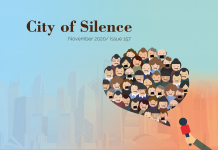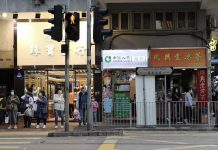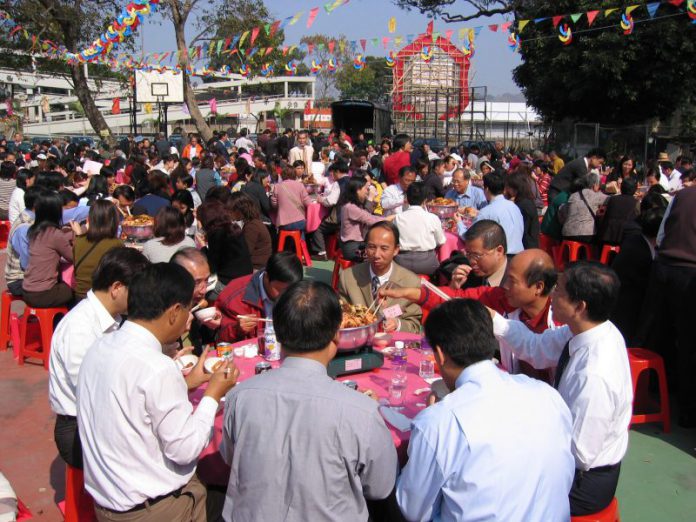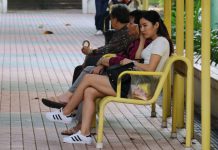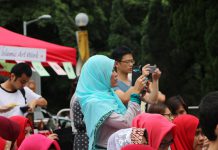Identity politics rears its head in New Territories indigenous villages
By Gloria Lee and Avery Tsui
Take a 10 minute walk from Sheung Shui station and you will leave the skyscrapers behind you and arrive at Sheung Shui Wai, a collection of indigenous villages and the home of the Liu clan,
The “wai” in Sheung Shui Wai means walled. Walled villages used to be common throughout southern China, including in the New Territories,walls were erected to protect inhabitants from pirates and other marauders. Many of the walls have now been partly or completely demolished and recent decades have seen big changes to tradtional village life.
Liu Oi-ting, 20, is an indigenous Sheung Shui Wai inhabitant, who takes pride in her indentity. “Being an indigenous inhabitant in the Wai village gives me a special sense of identity,” Liu says, but she acknowledges the bond among villagers is not as strong as it once was.
Liu’s sister is nine years older than her and she thinks her sister has a stronger bonding with other villagers because there used to be frequent activities that involved the whole village. “It is not the same in my generation.” says Liu.
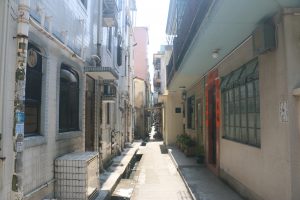
Over the years, indigenous villagers have moved out of the villages and outsiders have moved in. This changing demographic has also influenced village culture, says Liu. However, she thinks relations between indigenous and non-indigenous residents are generally good, except when there are conflicts over different living habits. For instance, there was a conflict between her family and the new immigrant family next door who would throw rubbish from their terrace that accumulated outside the Liu family’s front door.
In Sheung Shui Wai, non-indigenous residents are welcome at many village events, such as the mid-autumn festival gatherings and ‘poon choi’ feasts. But clan-based events, like the worship of ancestors rarely involve non-indigenous participants. Liu says this is more about clan membership than any kind of segragation. “No matter how integrated they are with us, they can never be part of our family, our ties can only be that of friends.” she explains.
Lee Hoi-choi who lives in Kam Tsin, an indigneous village not far from Sheung Shui-wai echoes Liu’s sentiments – but from the perspective of a non-indigenous villager. “Actually we [non-indigenous villagers) don’t want our ties with the indigenous people to be too intimate either,” says Lee who moved into Kam Tsin, the home of the Hau clan, 19 years ago. Lee says that overall, he enjoys good relations with his indigenous neighbours and there is little difference between the indigenous and non indigenous Kam Tsin residents.
However, Lee knows there is one big difference between himself and his indigenous neighbours and that is they have “ding” rights. This means that male indigenous villagers who are descended from the male line from a resident of a recognised New Territories village in 1898, can apply to build a house for himself in his own village as long as he owns his own land or can get government land at a premium.
This is sometimes easier said than done and Lee understands that some villagers cannot get the land or have financial difficulties in building their ding house for self-use. However, he also sees indigenous people selling their ding rights and he questions why they can retain this privilege when they are just profiteering from it.
“The biggest beneficiaries are not those who build the house,” Lee says, “it’s the people with power.” In the villages, those with the power are the village leaders and representatives on rural committees and the Heung Yee Kuk.
While the boundary between indigenous and non-indigenous inhabitants is not usually visible, it comes into focus when there are conflicts. Lee recalls a dispute he had with an indigenous villager who tried to build his ding house where it would block his carspace. Lee sought help from the village resident representative but nothing was done until he directly complainted to the Home Affairs Department.
“The resident representative [who is also an indigenous villager] is on their side.” Lee says, “It makes sense if he helps the indigenous people, right?”
In 2003, the government introduced a “dual representative” system in an attempt to balance the rights of indigenous inhabitants and non-indigenous villagers. Regardless of where they were born or live, indigenous villagers as defined by the clan register, have the right to elect an indigenous representative for the village, Whereas all residents of the village, including non-indigenous villagers who are Hong Kong permanent residents and have lived there for at least three years, can vote for the resident representative.
San Shek Wan Village in South Lantau is an example of a village where a non indigenous villager is the resident representative. In most indigenous villages, both representatives are indigenous inhabitants. Former legislator Albert Chan Wai-yip, has lived in the village for 19 years.
Chan says that despite the dual representative system, rural elections are essentially unfair to non-indigenous villagers. He says indigenous village representatives have more power than resident representatives because they are authorised to deal with matters relating to the traditional rights and interests of indigenous inhabitiants,According to Chan, whenever the government holds consulations on issues concerning the interests of indigenous people and Ding rights, “Any opposition from the resident representative will go down the drain.”
Chan has strained relations with the indigenous inhabitant representative in San Shek Wan Village.“I don’t really have any interaction with the family of the indigenous inhabitant representative,” says Chan, “We are sworn enemies.”
Chan says that 14 years ago, he tried to construct a water pipe running from a hillside water source to a car park for public use, but the indigenous representative. Mo Ngan-fuk damaged it with a hatchet. Chan says Mo told him he had no right to construct anything in the village unless he paid him HK$5000. “Basically, you need to pay the indigenous inhabitant representative whatever you do in the village.”
Eventually, the argument was settled with police mediation and Chan has had no interactions with Mo since then.
Despite his feud with Mo, Chan says the relationship between indigenous and non-indigenous inhabitants in other villages can be harmonious. He thinks it depends on the individuals concerned.
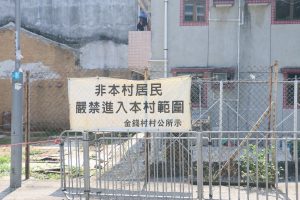
“It’s a matter of personality and attitude, I don’t think every indigenous inhabitant representative regards non-indigenous villagers as enemies.” says Chan.
Problems arise when indigenous representatives put personal benefits before the needs of villagers and abuse their power in handling affairs relating to the lawful traditional rights and interests of indigenous inhabitants. Besides, what constitutes their ‘lawful traditional rights and interests” is not without controversy. Ding rights have been criticised in recent years, and traditional customs meant that until 1994 indigenous women had no legal right to inherit property. The law that gave women the right to inherit was bitterly fought by the Heung Yee Kuk and other rural organisations.
However, Hau Fuk-tak, Kam Tsin’s indigenous representative of 22 years and 1st Vice-chairman of the Sheung Shui District Rural Committee and District Councillor for North District, holds a different view. He thinks there is nothing unfair about the situation where both the indigenous representative and resident representative is an indigenous villager.
“This just implies that the non-indigenous villagers would like to give the power back to indigenous inhabitants.” says Hau. Hau has been elected unopposed since 1998.
As the village representative and 1st Vice-chairman of the Sheung Shui District Rural Committee, Hau handles complaints from all villagers. He says most complaints in Kam Tsin are related to septic discharge or parking space, rather than disagreements between indigenous and non-indigenous villagers. Hau thinks non-indigenous villagers get along well with indigenous inhabitants in Kam Tsin.
Hau Lok-man, a 20-year-old indigenous villager who was born and raised in Kam Tsin agrees there is no distinct boundary between indigenous inhabitants and non-indigenous villagers. She recalls that as a child she played with other village children of her age and there was no question of avoiding non-indigenous kids.
Rather, it was at secondary school that she felt singled out for her identity as an indigenous villager during a Liberal Studies class. She still bristles at the memory, “I’m not entitled to any property or any money,” says Hau, “Actually I think there’s no difference between female indigenous inhabitants and other Hong Kong citizens.”
As a female, Hau does not enjoy ding rights under the New Territories Small House Policy while her brother can apply for it when he is 18 years-old. Hau thinks this is unfair, but she says she understands the policy was formulated in adherence to traditional Chinese patriarchal values.
“My father and brother won’t abandon me, so, it’s okay.” she assures herself.
Her mother, 49 year-old Ko Chi-mun thinks society wrongly assumes there is a tension between indigenous and non-indigenous villagers. “We have really good relationships with non-indigenous villagers,” says Ko, “It’s those living outside the village we have greater disagreement with.”
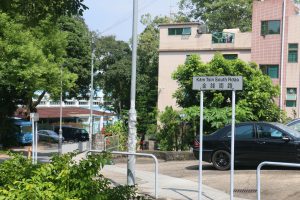
Ko thinks this may be because representatives from Rural Committee and Heung Yee Kuk have created a negative image that has tarnished all indigenous inhabitants. She points out that most indigenous inhabitants do not have any land and have the same access to resources that every Hong Kong resident has.
“When you have a small group of people boasting about how they as indigenous inhabitants have fields and land, the media exaggerates what they say and this magnifies the conflict between the indigenous and non-indigenous people.” says Ko.
Even among indigenous inhabitants themselves, underlying conflicts and boundaries exist. However, in order to maintain harmony in the village, villagers like Ko rarely speak out because they are afraid to upset the historical power dynamics that exist in the village.
As more and more indigenous inhabitants rent or sell their houses to outsiders, village culture will continue to evolve and change. The boundaries between indigenous and non-indigenous villagers may become blurrier or barely noticeable – that is, until there is a conflict. Under the current dual representative system, the indigenous village representative may be elected by fewer people but have more powers. Whether that power is abused depends a lot, as former legislator and long-time San Shek Wan resident Albert Chan says, on individual character and personality.
Edited by Joey Kwan




